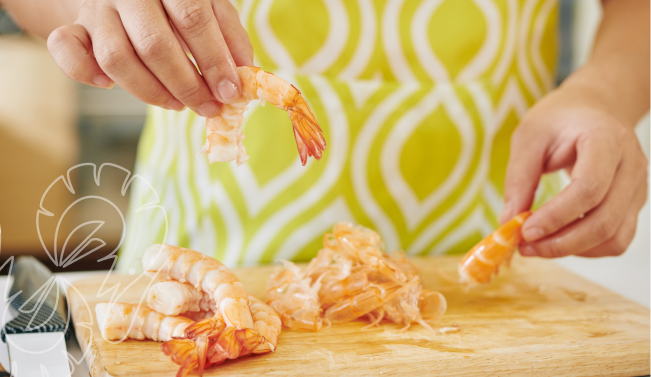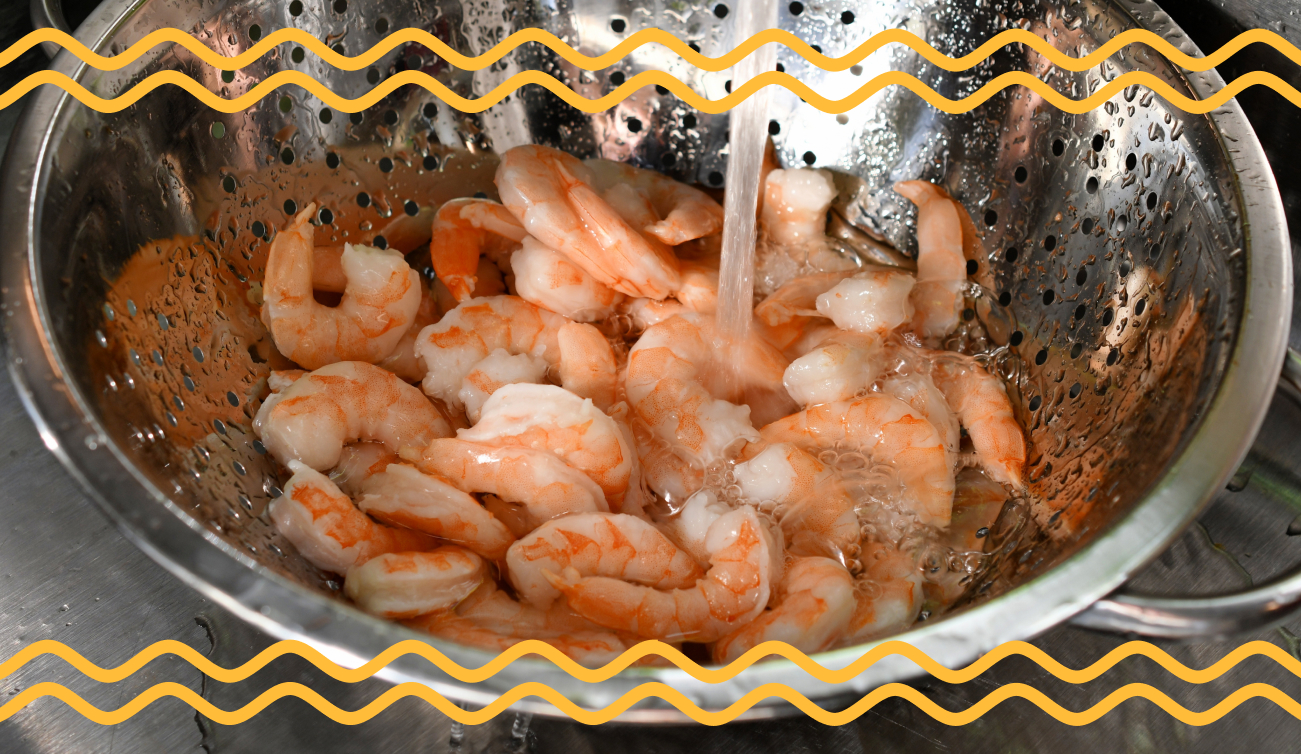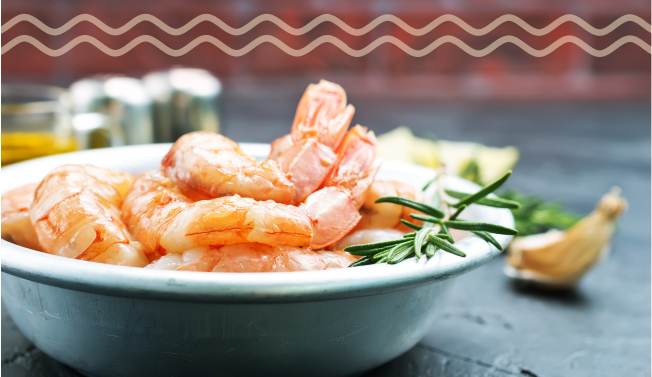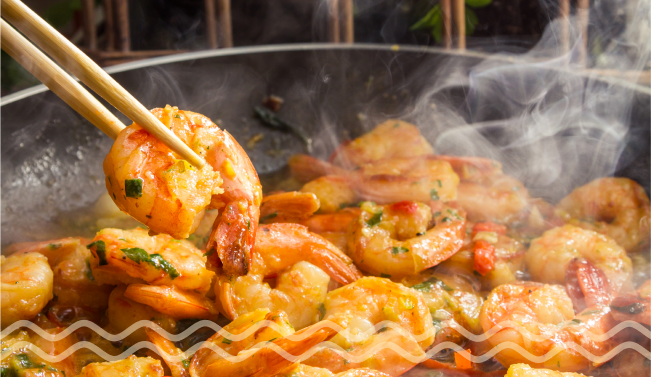The Health Benefits of Wild-Caught Shrimp
Texas Gold Shrimp on 1st Aug 2024
The smell of ocean and the sound of the engine cuts through the vast blue expanse ahead as the boat makes its way out of Port Isabel into the sapphire-blue water of the Atlantic Ocean. On deck, the crew are dressed in vibrant orange overalls. They’re busy preparing for the work ahead, securing lines, and checking kits. Above, the sky is clear with the occasional whisps of white clouds. The day will be a long one, but the bounty will be worth it. Gulf wild-caught shrimp are famously some of the best in the world.
The average American will eat 4 pounds of shrimp each year. Not only are they delicious, but they are surprisingly good for us. They are packed full of nutrients and protein and, when cooked right, they are one of the few available meats with a near superfood status.
So, what makes these little tasty critters so good for you? Why are wild-caught shrimp better than farmed shrimp? Are shrimp bad for you? And how can you include shrimp into your lifestyle?
With more than 70 years of experience, Texas Gold Shrimp has answered these questions, and more so you can take full advantage of one of the most versatile foods in the world.

Nutritional Value: What do wild shrimp eat?
The main reason wild shrimp are better for you than farmed shrimp comes from what they eat. Farmed shrimp live in rigidly controlled conditions. What they eat and how much is dictated precisely. There are economic reasons for this, but it also helps to control pests and diseases.
Wild-caught shrimp, on the other hand, will have an incredibly varied diet, consisting of different types of plankton and small sea creatures. This variety means that wild-caught shrimp are richer nutritionally (as well as more delicious!).
Macronutrients
At only 450 calories per pound, shrimp have an incredibly low-calorie count. We’ve put together some more nutritional information so you can see why we love shrimp as a health food:
Nutrition per lb:
Calories: 448.47
Fat: 1.359 grams
Carbs: 0.906 grams
Cholesterol: 856.17 milligrams
Sodium: 502.83 milligrams
Protein: 108.72 gram
Their low fat and high protein content makes them fantastic for anyone looking to build muscle or lose weight, while still enjoying eating delicious meals.
Micronutrients
Due to their often unique diet, the density of micronutrients in wild-caught shrimp is often higher and more varied than in their farmed alternatives. They provide a rich source of:
- Phosphorus
- Copper
- Zinc
- Magnesium
- Calcium
- Potassium
- Iron
- Manganese
With their low health impact and concentration of micronutrients, they form an essential part of someone seeking a balanced diet.
What’s The Difference Between Wild-Caught Shrimp And Farmed Shrimp?
Fishmeal is a dried powdery substance often made from the bycatch of commercial fishing. Any fish that can’t be sold but has accidentally been caught is crushed and pressed into fishmeal. This is typically the staple for farmed shrimp.
Due to their less varied diet, farmed shrimp often have a milder flavor and softer texture. This also impacts their nutritional value. Because of their intensely controlled diet, they tend to be lower in nutrients and higher in cholesterol.
Another factor to consider is that farmed shrimp are much more prone to disease. Cramped conditions and a monoculture environment create a breeding ground for disease and pests. To manage this, farms often pump antibiotics into the water. While helping to prevent disease, these drugs can seep into the food chain and impact humans.
With their varied and natural diet, strong immune system, and better quality of life, wild-caught shrimp are a more sustainable and nutritious option in almost every case.

Is Wild-Caught Shrimp a Superfood?
A superfood is a food that is exceptionally high in nutrients. Its density means that you can get much more for less. Their variety of nutrition supports immune response, promotes normal bodily functions, and improves your longevity.
As we’ve seen, wild-caught shrimp have a great nutritional profile, with plenty of trace minerals your body needs. The reason they’re a contender for superfood status is because they are outstanding in several other areas:
High Density of Good Quality Protein
Protein is essential for growth and repair. The more protein in your diet, the greater your capacity to grow muscle and recover from injury.
Pound for pound, shrimp has more protein than pork. Not only this, but the type of protein available is very high in amino acids, easy to digest, and simple to incorporate into the body.
Omega-3 Richness
Omega-3 is something your body is unable to create on its own. You have to eat it. It plays a crucial role in many of the body's functions and may help with things like heart disease, autoimmune issues, and depression.
Wild-caught shrimp contains higher levels of Omega-3, making it a healthy and delicious way to ensure your body has what it needs.
Variety Of Essential Minerals
Wild-caught shrimp pack a punch for their size. They contain minerals the body needs to survive and can’t find anywhere else. They need to be eaten as part of a balanced diet.
The iron in shrimp helps your blood transport oxygen from the lungs to the body. It’s also critical in the formation of DNA. Phosphorous is essential for bone and teeth creation and maintaining healthy cells. Zinc helps your cells heal and is crucial for hundreds of reactions that keep your body running each day. Manganese is important for your metabolism.
Wild-caught shrimp offer a low-fat, low-calorie, high-protein way to give your body all of these minerals.

Are Shrimp Safe to Eat?
Shrimp are subject to the same risks that impact all of the food we get from our oceans. Intensive farming, commercial waste, and our own reactions to food are things that you need to consider when it comes to understanding if you want to enjoy more shrimp as part of your diet.
Can Shrimp be contaminated by Antibiotics and Chemicals?
While this mainly impacts farmed shrimp, the drugs that farms use to treat their shrimp can often bleed into the surrounding environment, causing contamination. The ocean can also be used as a dumpster for chemical waste, which can seep into shrimp, too. Not all of this has an adverse physical impact on humans. However, different drugs and chemicals can impact the reproductive cycles of shrimp, leading to less reliable catches and population decline.
The best way to avoid this type of contamination is by buying wild-caught shrimp from reputable suppliers. They will reduce the contamination risk and ensure that the shrimp you provide for your friends and family is safe.
Can you be allergic to shrimp?
Yes. Shrimp are classified as shellfish, which can cause an allergic reaction (anaphylaxis) in sensitive individuals. The symptoms of a shellfish allergy are :
- Hives
- Itchy, irritated skin
- Nasal stuffiness (congestion)
- Swelling of the lips, face, tongue, throat, or other parts of the body
- Wheezing or trouble breathing
- Coughing and choking or a tight feeling in the throat
- Belly (abdominal) pain, diarrhea, nausea or vomiting
- Dizziness, lightheadedness or fainting
If you have been diagnosed and are likely to be in a restaurant that handles shellfish such as shrimp, remember to bring your epi-pen. Always tell your host or staff about your allergy. If you haven’t been previously diagnosed but start to feel any of the symptoms above, stay safe and see a doctor as soon as possible.

Integrating Wild-Caught Shrimp into a Healthy Lifestyle
Several methods yield delicious shrimp from a huge variety of recipes:
- Sauteed
- Grilled
- Roasted
- Poached
Each method gives slightly different results and varies in terms of health. Naturally, cooking with oil is fattier than poaching or steaming.
The critical thing to remember is that shrimp are delicate and easy to overcook. They are done once their flesh is pink, and they’ve curled into their famous “C” shape. They will continue to cook once they’ve been taken off the heat, so it’s good practice to take them off the heat a little earlier and let them rest. Your shrimp is overcooked if it is tough and bland.
Simple Must Try Shrimp Recipes
Texas is famous for its shrimp. But you can capture their incredible flavor at home too. Apart from some of the ideas below, we have a full shrimp recipe section on our site, so head there if you want to get inspired for your next meal.
The most simple and delicious option is to sautee shrimp in butter, pepper, garlic, and lemon for 5 minutes. This works best with medium shrimp. You can skewer them and grill them this way too after marinating them.
Shrimp ceviche is also a straightforward and simple recipe. Grate some ginger, garlic, and chili in a bowl. Add the zest and juice of a lemon along with a pinch of sugar and a teaspoon of salt. Add some bruised coriander and leave in the fridge overnight. Fry off your shrimp for a few minutes and add to the strained ceviche juice. Add the shrimp then cover and chill them for 30 minutes. Chop some onion, avocado, and tomatoes and add to the chilling mixture. Wait another 30 minutes and serve.
Shrimp can be added to pasta sauce or tossed in a salad. They really are a food for every occasion.
Shrimp as part of a Healthy Diet
The concentration of omega-3 fatty acids, complex proteins, macronutrients, and micronutrients makes shrimp an unmissable part of a healthy diet. To help avoid some of the possible downsides like antibiotics and contamination, always buy your shrimp from certified suppliers who have a track record of sustainability.
Texas Gold Shrimp has worked naturally and sustainably for decades. If you have any questions about how we source our wild-caught shrimp and the things we do to ensure quality then please don’t hesitate to contact us.
Ready to buy? Head over to our store to order your shrimp and we'll have it delivered to your door.
FAQs
Is wild-caught shrimp a healthier option?
There are lots of health benefits to eating shrimp. There are also risks of eating shrimp. As with all things, balance is key, and including shrimp as part of a varied and balanced diet can only be a good thing. They are nutritious and low in calories and fat. But, as with all seafood, they can be contaminated and are impacted by mercury levels in the water.
What are the health benefits of consuming wild-caught shrimp?
With their varied diet, wild-caught shrimp have a much better nutrient profile than farmed shrimp. They are high in omega-3 fatty acids and contain a wide range of macro- and micronutrients that promote everything from brain function to DNA repair.
Why is shrimp considered a superfood?
A superfood is a food that contains an unusual amount of nutrients in a small portion. Wild-caught shrimp, with their high levels of good-quality protein, extensive micronutrient profile, and low calorie count, are widely considered a superfood.
How does the healthiness of shrimp compare to fish?
Shrimp are crustaceans and often have a different diet than fish, especially larger fish. Larger fish or carnivorous fish suffer from higher concentrations of mercury. Shrimp often have higher levels of protein, but it’s important to note that the nutritional content of shrimp can vary with season and the area they’re caught. Mostly, the nutritional profiles of shrimp and fish overlap.

